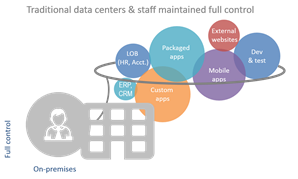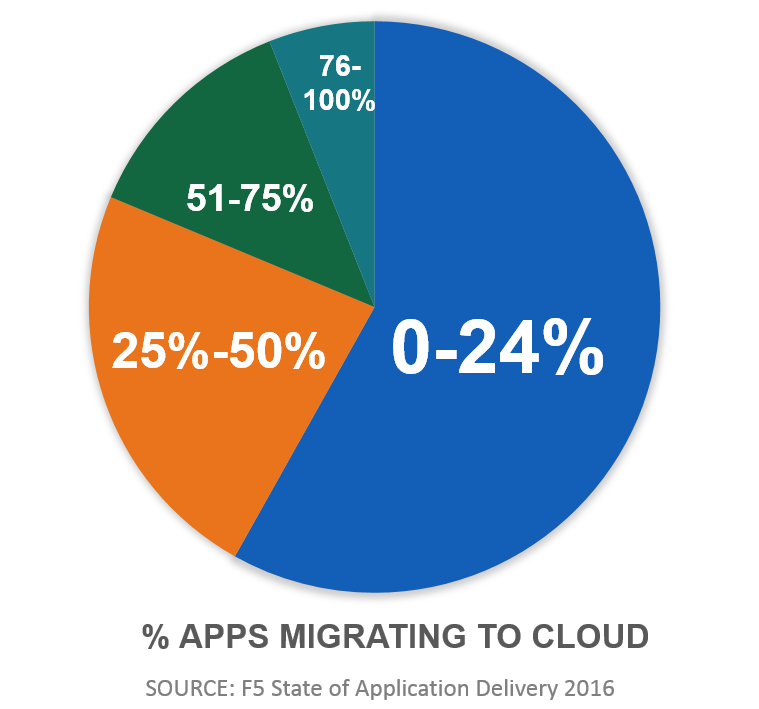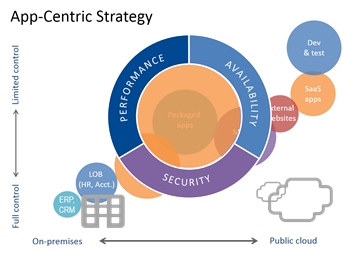あなたのクラウド戦略はアプリ中心ですか?

昔は、アプリケーションは単一のインフラストラクチャの下で集中管理されていました。 データ センターの境界は保護されており、簡単に識別できました。 IT スタッフには、すべてのアプリケーションの可用性、パフォーマンス、セキュリティを確保するという任務がありました。
IT 部門は、アプリケーションのライフサイクルと展開のあらゆる側面を完全に制御できました。
しかし、それは昔のことと言われますが、これは今です。 現在、アプリはプライベート クラウドとパブリック クラウドへの移行を続けています。 CIO は制御を犠牲にして俊敏性とコスト削減を実現しており、アプリケーションはさまざまなクラウドベースのモデルでオフプレミスに導入されることが増えています。

大多数の組織は、アプリケーションの最大半分をクラウドに移行しています。 SaaS は引き続き最も人気のあるクラウド モデルであるため、基幹業務アプリが移行の大部分を占めていますが、この動きはそこで止まりません。 モバイル アプリケーションの数が急増する中、プライベートおよびパブリック IaaS モデルがますます求められています。
今日、IT 部門は、ますます多様化する環境全体にわたってアプリケーションの可用性、パフォーマンス、セキュリティを開発、展開し、確保する必要があります。 これは「ミッションクリティカル」なアプリケーションだけのものではありません。 ダウンロード数とエンゲージメント率で通貨が測定されるアプリ経済では、すべてのアプリケーションは高速で、安全で、利用可能でなければなりません。
毎。 シングル。 アプリ。
変わっていないのは、組織がセキュリティ、パフォーマンス、可用性を確保するためにアプリケーション サービスに依存し続けていることです。 基本的な負荷分散であれ、一連のアプリケーション最適化であれ、アプリケーション セキュリティであれ、クラウドによって他のすべてが変化を余儀なくされる中で残る唯一の真実は、アプリケーションがどこに展開されていても、アプリケーションにはそれらのサービスが必要であるということです。 つまり、クラウドに移行するアプリケーションも含め、すべてのアプリケーションに対してアプリ中心の戦略を採用するということです。
アプリ中心の戦略
クラウドは強制機能です。 これにより、IT 部門はビジネス モデル、ネットワーク アーキテクチャ、導入方法、さらにはハードウェアやソフトウェアの好みまでも変更するようになりました。 したがって、組織がアプリケーションを保護し、配信する方法にも戦略的な変更を迫られるのも当然です。 「クラウドファースト」戦略を採用するだけでは不十分で、アプリにも重点を置く必要があります。 クラウドに移行することで運用コストを削減しても、パフォーマンスの低下により生産性が低下したり利益が失われたりしてしまうのであれば、それは本当に成功した戦略とは言えません。

純利益が 0 なら (運が良ければ) 成功とは言えません。 単に帳簿上の数字を移動しているだけです。
必要なのはアプリ中心の戦略です。 展開モデルに関係なく、すべてのアプリに対して一貫した配信サービスを保証します。 異なるクラウド環境の複雑さを抽象化し、DevOps アプローチをサポートしながらスキルとポリシーを継続的に使用できるようにする戦略。
これは、アプリケーションから始まり、成功で終わる戦略です。
この戦略により、当社は引き続き拡大と革新を進め、BIG-IP が提供する配信およびセキュリティ サービスと、BIG-IQ が提供する管理およびオーケストレーション機能を改善し、お客様がアプリケーション中心のクラウド戦略を成功裏に実行できるようにしています。 アプリがクラウド、オンプレミス、またはサービスとしてどこに展開されるかに関係なく、パフォーマンス、セキュリティ、可用性を確保するためのサービスが必要です。 そして、それらのサービスを一貫して展開および管理できる必要があります。
F5: アプリ中心の戦略の成功を実現する
そのため、本日、私たち(企業としての私たち)は、組織がまさにこのようなアプリケーション中心の戦略を成功裏に実行できるようサポートするために、BIG-IP 12.0 のさまざまな改善、機能強化、新機能の追加を発表できることを嬉しく思います。
BIG-IP 12.0 は、SSL Everywhere、拡張された不正防止、Office 365 などのブラウザレス環境をサポートする主要な SAML 拡張機能による SSO の改善、プライバシーとメッセージの整合性を強化する ECC、FS、Camellia などの最新の暗号化暗号のサポートなど、最新のアプリケーション セキュリティ オプションを提供します。 拡張キャッシュ機能と HTTP/2 を備えたハイパースケール DNS により、企業はアプリケーションに高額な変更を加えることなく、オンプレミスとクラウドの両方で Web アプリとモバイル アプリのパフォーマンスを向上させることができます。
F5 は、BIG-IQ と BIG-IP を使用して、プライベート クラウド、パブリック クラウド、SDN、従来の環境にわたるオーケストレーションと管理のオプションを継続的に拡張しています。 Microsoft Azure は、Cisco ACI、VMware NSX、OpenStack、VMware vCloud Air、Amazon Web Services などのすでに広範なエコシステムに加わります。 F5 は、クラウドと DevOps イニシアチブをサポートし、仮想軽量ロードバランサー LineRate Point を含む、すでに幅広いソフトウェア オプションを補完する新しい強化されたプログラマビリティ ツールを導入しています。 DevOps 実践者は自動化の取り組みに API とデータ パス スクリプトを利用しており、これをサポートするために、iRule エディターと強化された iControl API を提供しています。
これらすべての改善、機能強化、追加(および特に言及されていないその他の機能)は、開発から運用、ネットワーク、セキュリティに至るまで、IT 全体がクラウドへの視野(およびアプリの展開)を拡大し続けながら、アプリ中心の戦略をうまく開発および実行できるように設計されています。
